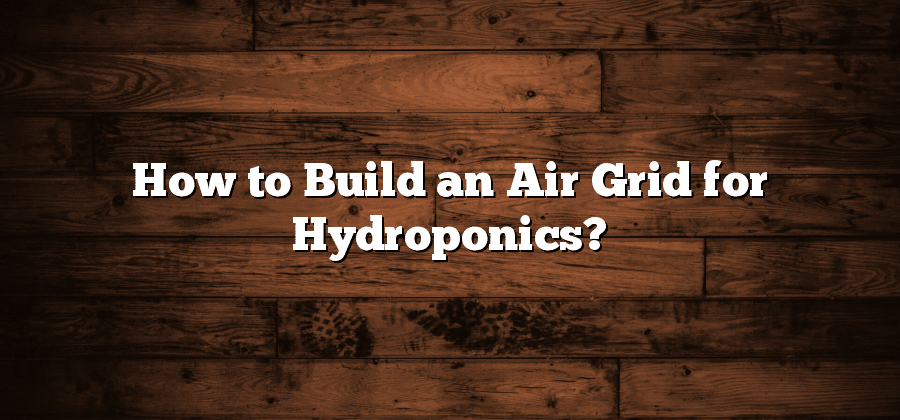Understanding the Benefits of an Air Grid
An air grid is a valuable and practical tool for a variety of industries and applications. It is a network of air stones and tubing that delivers oxygen to water or nutrient solutions, providing much-needed aeration and circulation. The benefits of using an air grid are numerous and can greatly enhance the success and efficiency of various systems.
Firstly, an air grid ensures that oxygen is supplied evenly throughout the entire solution, promoting healthier and more vigorous growth. This is especially important in hydroponic and aquaponic systems, where the roots of plants or fish rely on dissolved oxygen for optimal function. By delivering a constant stream of oxygen, an air grid prevents the formation of stagnant pockets and ensures every part of the solution receives adequate aeration. The improved oxygen uptake leads to faster growth, stronger root development, and increased nutrient absorption, resulting in healthier and more productive plants or thriving aquatic life. Additionally, the enhanced circulation achieved by an air grid helps to prevent the buildup of harmful gases, such as carbon dioxide, that can negatively impact the system.
Selecting the Right Materials for Your Air Grid
When it comes to selecting the right materials for your air grid, it is crucial to pay attention to quality and durability. The air grid system relies on a network of materials that can withstand the pressure and constant flow of air. One of the key components to consider is the air tubing. It is important to choose tubing that is made of a flexible and durable material such as PVC or rubber, as this will ensure that the air is delivered efficiently throughout the grid. Additionally, a proper selection of air stones is imperative. These stones are responsible for diffusing the air and creating small bubbles, which in turn facilitate optimal oxygenation. It is advisable to choose high-quality, porous stones that are resistant to clogging and can withstand long-term use in aquatic environments.
Planning the Layout of Your Air Grid System
When planning the layout of your air grid system, it is important to consider the overall size and shape of your water feature. The goal is to evenly distribute air throughout the water, so you will need to determine the optimal placement of air stones and tubing. One key factor to consider is the depth of the water. It is generally recommended to position the air stones closer to the bottom of the water feature, as this allows for better circulation and aeration. Additionally, you will want to ensure that the air stones are evenly spaced apart to achieve uniform bubbling and a visually appealing display.
Another important aspect to consider when planning your air grid layout is the size and number of air stones to use. The size of your water feature and the amount of oxygenation it requires will determine how many air stones you will need. It is generally recommended to use multiple smaller air stones instead of one larger stone, as this allows for better distribution of air and prevents the formation of dead spots in the water. Additionally, positioning the air stones in a grid-like pattern can help to maximize the aeration and ensure that every corner of your water feature is properly oxygenated.
Building the Framework for Your Air Grid
When it comes to building the framework for your air grid system, it is important to carefully plan and strategize to ensure a successful installation. The first step in this process is to gather all the necessary materials and tools, such as PVC pipes, connectors, and clamps. These materials should be of high quality to ensure durability and longevity of your air grid system.
Once you have the materials ready, begin by measuring and marking the desired location of your air grid. It is crucial to ensure that the framework is level and properly aligned to avoid any potential issues later on. Using a saw or pipe cutter, carefully cut the PVC pipes to the required length, making sure to consider any bends or turns in the grid layout. Connect the pipes using the appropriate connectors, securing them tightly with clamps or PVC cement. This will create a strong and sturdy framework for your air grid system.
Remember, the framework is the backbone of your air grid system, providing stability and support. Therefore, it is essential to take the time and effort to build it correctly. By following these steps and using quality materials, you can ensure that your air grid framework will be reliable and efficient, allowing for optimal airflow and oxygenation in your system.
Installing the Air Stones and Tubing
To effectively install the air stones and tubing in your air grid system, it is vital to follow a systematic approach. Begin by positioning the air stones in the desired locations within your pond or tank. Ensure that they are evenly spaced to ensure optimal oxygen distribution. Connect the air stones to the main air tubing using suitable connectors, making sure they are securely attached. It is essential to use high-quality tubing that is durable and flexible enough to accommodate any necessary adjustments or expansions in the future.
When routing the air tubing, it is crucial to plan the layout carefully. Avoid any sharp bends or kinks in the tubing, as this can hinder the flow of air. Instead, opt for gentle curves and straight sections to ensure a smooth and efficient distribution of air bubbles. Secure the tubing in place using appropriate clips or clamps, ensuring they are tight enough to prevent any leakage. It is recommended to leave some extra tubing length to accommodate any future modifications to your air grid system.
Installing the air stones and tubing may seem like a straightforward task, but it requires attention to detail and precision. By following the above steps and ensuring proper placement and attachment, you can maximize the effectiveness of your air grid system and provide a well-oxygenated environment for your aquatic inhabitants.






